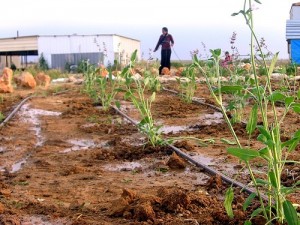 IBM builds a solar power desalination pilot plant in Saudi Arabia.
IBM builds a solar power desalination pilot plant in Saudi Arabia.
News that Saudi Arabia, the world’s largest market for desalination plants, is planning future solar-powered reverse and osmosis projects has been met with general enthusiasm by environmentalists and non-environmentalists alike. However, while politicians in the region play up the significant advantages of modern desalination, a deeper cost-benefit evaluation shows these investments come at a considerable cost.
Technically, desalination is a proven but still evolving technology. In the Arab world and particularly in the Persian Gulf region, desalination is logically the only hope to meet water demand, as perennial and ground water sources cannot keep up with the ever- growing population.
Official statistics show that Saudi Arabia is the world’s largest producer of desalinated water representing 30% of global production. The 30 desalination plants in Saudi Arabia meet 70% of the drinking water needs of the country, using a relatively energy-intensive process to run the huge equipment needed to extract salt and other minerals.
Replacing fossil fuel by sun to desalinate seawater should in theory relieve dependence on fossil fuels. This in turn could save on energy costs, reducing the “bleeding of oil from the natural reserves”, while coping with the water needs of a growing population and increasing urbanization. In addition, green technology could help build green credentials for the Kingdom while helping secure water security to its citizens who can expect their bills to be further reduced by 40 percent.
As good as this may sound, solar desalination is however not the “silver- bullet” solution that the world is waiting for. Large-scale desalination brings with it equally large-scale environmental challenges. The huge quantities of brine reject, chlorine and other chemicals that return as heated brine concentrate into the Arabian Gulf have taken a heavy toll on the marine environment. Declining fish stock, deterioration of coral reefs and recent links to the devastating red tide are evidence of this deterioration.
With the cost of the desalinated cubic meter of fresh water decreasing through technological improvements, regional governments could use such savings to impose higher environmental standards, forcing bidders to find a no-reject solution while also increasing the use of renewable energy to power such plants.
Besides technical improvements, more efficient practices like harnessing rainfalls and full recycling of gray and black water for reuse can also offer easy environmental wins. In many Arab countries as much as 40% of water produced is lost through leaks and evaporation. The demand side is also screaming for better practices. Cheap and often free water is not providing any incentives to save or reuse water. Reducing unlimited demand by pushing conservation methods among citizens is key. This may not help buy citizen loyalty or be in corporate interest, but other countries have shown that water use can be cut significantly and relatively painlessly when people have more incentives to conserve.
Going forward, given the region’s fresh water scarcity, desalination will continue to play a critical role. However the technologies that are so desperately needed are ones that target low or even zero carbon emissions and result in zero discharge of brine and chemicals into the oceans.
Large-scale desalination comes with environmental and economic costs that must be factored in and wherever possible mitigated.
Read more on Saudi Arabia and desalination:
Saudi Arabia to Create Solar Powered Desalination
Saudi Arabia’s Solar Market is a $50 Billion Opportunity
Environmental Challenges of Desalination




Don’t forget Atmospheric Water Generation systems. The gulf climate generally has a high humidity. These systems are also energy intense, but they can be easily powered by solar.
I wish more people were as lucid about environmental issues. It is time for the conscience to wake up, more awareness is needed, more articles of this type should be published, to reach the public and hopefully generate engagement.
I like this article. It is spot on about the problems with our region and the ostrich attitude of our governments